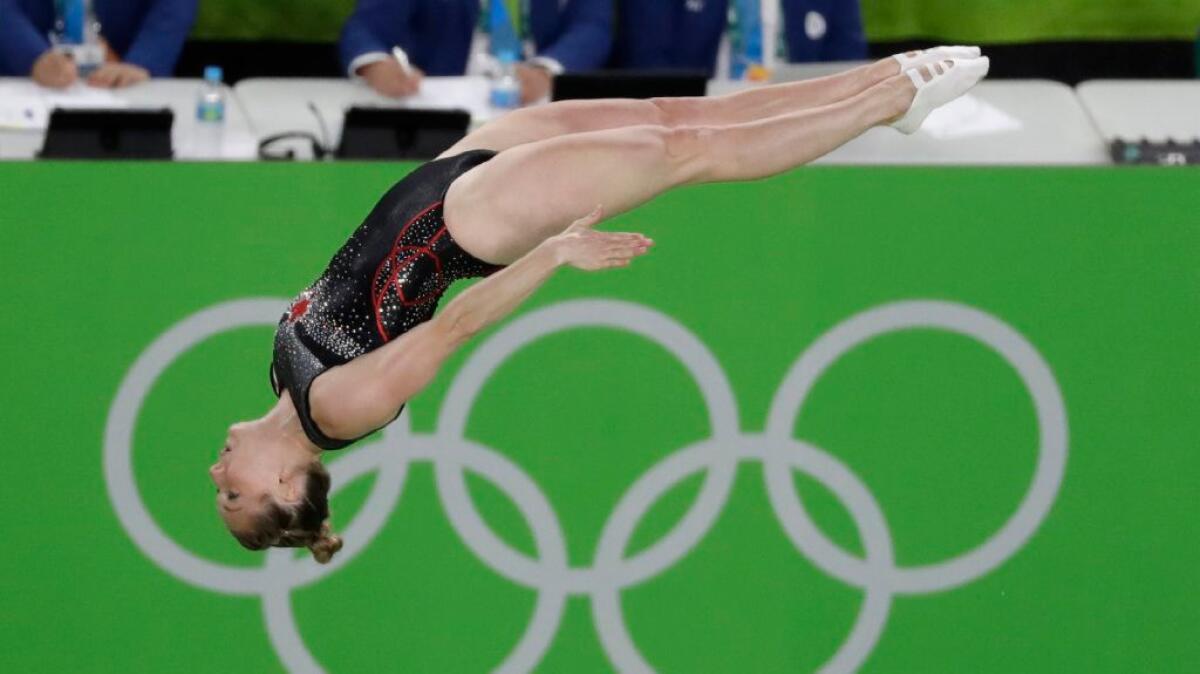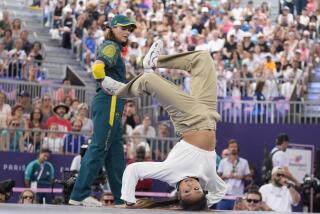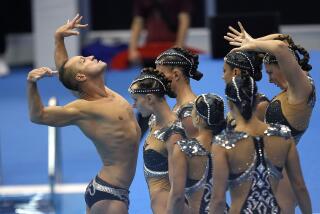Bouncing with Canada and how to break a tie

Reporting from Rio de Janeiro â A look back at day seven of competition at the Rio Olympics.
We love the Canadians
If you have to have a country next door, you would want it to be Canada. Everybody loves them. They talk like we do but with some funny affectations, eh! And they are just all-around good people. So, itâs with great pleasure to see that they are continuing their role as a world power in trampoline. This isnât donât-get-any-potato-salad-on-it trampoline, this is a scary, high-flying type of bungee jumping without the bungee.
Four years ago, Rosie MacLennan won the trampoline competition for Canadaâs only gold medal of the London Games. It was as if the Canadiansâ motto was âown the bronzeâ as they won 12 of those medals to go with five silver and MacLennanâs gold. Well, Rosie did it again in Rio on Friday. When you add in the shared gold by swimmer Penny Oleksiak in the 100-meter freestyle, our friends to the north have doubled their gold total in these Games.
So hereâs wishing them continued luck.
A three-way tie, really?
Ties are natureâs way of returning everyone to fifth grade where everybody gets a ribbon. Or youth soccer games in which no score is kept.
Michael Phelps, Chad le Clos of South Africa and Laszlo Cseh of Hungary all had that feeling when they finished in a three-way tie for second in the menâs 100 butterfly. What are the mathematical chances that all three would finish in exactly 51.14 seconds? Actually the odds are the same they would finish in 51.13 or 51.15. Nonetheless, they all finished behind Joseph Schooling of Singapore, who won in 50.39.
So, has anyone given any thought to how to break a tie like this? The obvious answers are rock-paper-scissors or cutting cards. You could even draw straws. But this is swimming, and there is a logical answer: who can hold his breath underwater the longest? It wouldnât take too long, you hope. Now, if you donât like that idea, how about a spirited game of Marco Polo?
Obligatory drug item of the day
So a Chinese swimmer, a Polish weightlifter and a Bulgarian steeplechase runner walk into a bar . . .
OK, not a joke, but Chen Xinyi, Tomasz Zielinski and Silvia Danekova were shown the door after testing positive for banned substances. Chen actually was suspended provisionally until a final ruling is issued. But it doesnât matter because swimming is over.
Zielinskiâs positive was for an anabolic steroid and Danekovaâs was for EPO, a hormone favored by professional cyclists, if you know who we mean. Chenâs was for a diuretic.
Best thing, though, is this is a little faster than the four-to-eight-year lag time on previous positives this week.
Honest, the dog ate my homework
On day six, you heard the tale of the Kenyan track coach being sent home after he was caught pretending to be an athlete and falsifying a drug test. Well, he told his side of the story on Friday and itâs a doozy.
The Kenyan delegation was bigger than the number of rooms they had in the athletesâ village, so 61-year-old John Anzrah was staying at a hotel. According to Kenyan media, his credential did not allow him into the dining hall at the village, so he borrowed the credential of an athlete so he could get a free lunch. Thatâs when he was nabbed by the doping narcs, who allegedly made him submit a sample and also sign papers that he was the athlete. What is the expression? There is no such thing as a free lunch.
Anyway, is that a plausible explanation? Kenyan officials decided to send him home, presumably on an international flight where meals are still served in coach class.
Of course we highlight Americans
Itâs time to honor the American fencing team, which won its first medal in the foil (aluminum or tin?) competition in 84 years, or the same amount of time it takes Uranus to orbit the sun.
The four swashbucklers were Alexander Massialas, Gerek Meinhardt, Race Imboden and Miles Chamley-Watson, a great name for a fencer if weâve ever heard one.
Another American to honor is archer Brady Ellison, whose trip to Rio in seat 11J was chronicled earlier this week. He came within a whisker of winning gold but had to settle for bronze in the menâs individual competition. Itâs his third medal to go along with team silvers in Rio and London.
You canât handle the truth
You have to love the honesty of our synchronized swimmers. The U.S. has an entry only in duet competition because, well, it isnât good enough to have a team entrant. So, what are the U.S. duet chances?
Mariya Koroleva: âWeâve seen a lot of the other duets that weâre going up against and no, I wouldnât say weâre going for a medal.â
And how about the green pools that are multiplying at the non-swimming aquatics center?
Anita Alvarez, partner of Koroleva: âWe trained these routines so much, we could do them with our eyes closed, we could do them in our sleep. We donât wear goggles when we compete so itâs already not going to be super clear under there.â
Synchro swimmers say the darnedest things.
Help provided by Times staff writers Kevin Baxter, Lisa Dillman, Helene Elliott, Nathan Fenno, Bill Plaschke and David Wharton.
More to Read
Go beyond the scoreboard
Get the latest on L.A.'s teams in the daily Sports Report newsletter.
You may occasionally receive promotional content from the Los Angeles Times.







